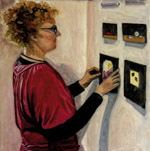Oh yes, I have waited for this change such a long time, but I’ve never dreamed of a year like this that still feels like: everything in one go and even more.
In April my partner and I started to look for a house for us… and found the right one already at the 2nd trial. OMG, to pay for it I needed to sell my house in Bremen before… and we booked a holiday for May.
So, before the holiday we had to clean and make up the house so that we can show the house like I would like to show it, just 120m² plus basement plus garden. You can imagine…
Just after the holiday in the mountains I offered the house online and I was already nervous that the house would sell as fast as I needed the money… It took… just 4 weeks in the beginning of July. Yeah!
The notary and the buyers, who went on holiday in summer, were quite quick.
However, in the meantime I had make up my mind about what furniture I wanted to keep and wanted to sell or just to get rid of. At the same time we worked on how to share and use the rooms and where to put which table because our plan has been to live and work at the same place: My partner needs two office rooms and I need my studio.
In the beginning of August I started packing and painting the walls in the new home. I moved on August 16th, my piano one day later. My partner arrived 2 weeks later with his private part and the weeks later with his offices. So, in the middle of September we could start to settle in and down, and you can imagine that takes time, especially if you are two people who had been living alone for more than 5 years.
September? Now we have December – indeed we have. So, you can imagine there was more: My mum got weaker and weaker and died on October 14th and my health was more than fragile. Also, Covid came round for the second time and I must say it still totures me.
However, I’m happy to have left the city of Bremen to live in the countryside now just behind the borders of Bremen. We’ve got a wonderful garden that is an invitation to teach students here. That is my plan next to paint in my studio and in the fields. But this December we have snow over here and this covers everything with a blanket and even brings more silence to calm down what we both really need.























